If you’ve got pets who love to swim, you know the struggle: fur everywhere, especially in the pool. Suddenly, your relaxing backyard oasis turns into a hairy mess, and the filter just can’t keep up.
Honestly, the best way to keep pet hair out of your pool filter is by throwing on simple tools like skimmer socks, pantyhose, or pre-filters over the skimmer basket. They’ll snag the hair before it ever makes it to your filter system.
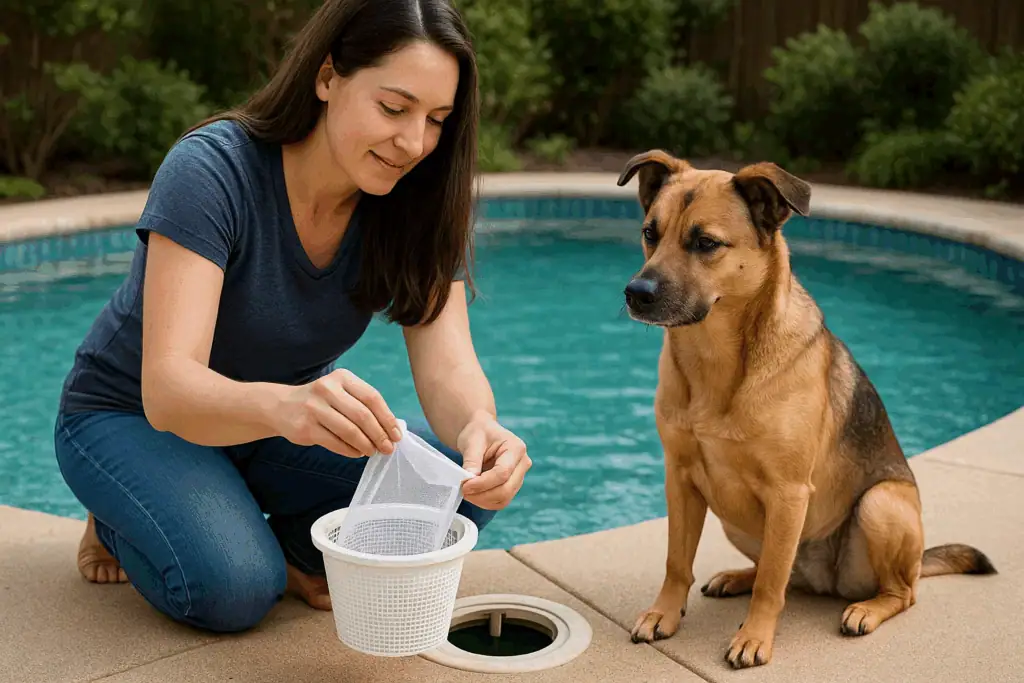
These cheap fixes save you from expensive repairs and make pool cleaning less of a chore.
If you’re a pet owner, you’ll appreciate how much time you save and how much better your swimming pool looks. It’s not rocket science—just some straightforward steps and you’ll have a pool everyone can enjoy (yep, even the four-legged swimmers).
Understanding the Impact of Pet Hair on Pool Filters
Pet hair causes headaches for pool owners by jamming up equipment and making the water look, well, less than inviting. If you know how hair gets in, what it does to the filter, and how it affects water quality, you’re already halfway to solving the problem.
How Pet Hair Enters Pool Water
Dogs shed all the time, and it gets worse when they swim. Even pups with short coats can leave behind more hair than you’d think.
As soon as pets hit the water, loose hair clings to their wet fur. All that splashing and swimming shakes it loose into the pool.
But it’s not just about swimming. Hair can blow in from the yard or from pet beds nearby. If your dog shakes off after a dip, even more fur ends up in the water.
Effects on Pool Filter Performance
Pool filters are meant to grab dirt, leaves, and tiny particles. Pet hair, though, is stringy and tends to clump, which makes it tricky for filters to catch and break down.
If too much hair gets in, it blocks or slows the water flow. The pump has to work overtime, and that can wear it out faster.
You’ll probably have to clean the filter cartridge or backwash a sand filter more often. If things get really hairy (pun intended), the whole system struggles and the pool turns cloudy.
Risks to Water Quality and Filtration System
Pet hair isn’t just a nuisance—it grabs onto oils, dirt, and whatever else is on your pet’s skin. That becomes a breeding ground for bacteria and other gunk.
When the filter can’t pull out all that hair and grime, water quality drops. Suddenly you’re dealing with cloudy water, algae, and that weird smell nobody wants.
If the filter gets too clogged, the pool’s circulation slows down. Chemicals don’t work as well. Worst case? The whole system can break, and that’s not cheap to fix. Staying on top of pet hair keeps your water clear and your equipment in good shape.
Using a Pool Skimmer Sock to Capture Pet Hair
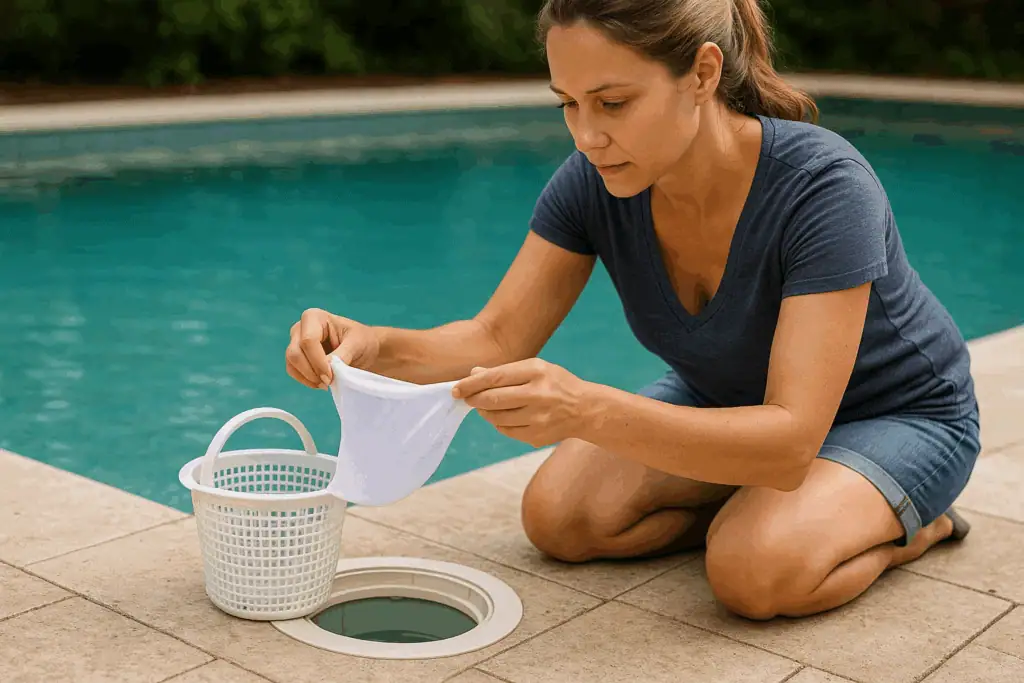
Anyone who swims with a shedding dog knows how fast fur clogs a pool’s filtration system. Even high-end cartridge filters struggle to trap lightweight strands that drift through water and then embed themselves in skimmer baskets, pump impellers, and return lines.
Why a skimmer sock solves furry-pool problems
A simple, inexpensive fix is to use skimmer socks. Made of fine-mesh nylon, the stretchy sleeve fits around your skimmer basket like a woven net, creating a pre-filter that stops debris smaller as small as polen.
Because the weave is tighter than the plastic basket holes, it captures tufts of pet hair before they escape into the plumbing, yet allows full water flow so the pump never starves.
The sock also snags pollen, insects, and plaster dust, leaving the pool surface noticeably clearer. By preventing fur buildup down-stream, you can extend filter cycles, reduce backwashing frequency, and protect the pump’s mechanical seal for many seasons.
I have used skimmer socks for many years. I no longer need to use them to trap dog hairs since my dog Oscar died, as my other dog hates water. However, my neighbours tree drops pollen for many months which the skimmer socks trap.
Check out this 100 pack of skimmer socks.
Quick installation and care routine
Installing a skimmer sock takes less than a minute.
- First, switch off the pump, remove the skimmer lid, and lift out the basket.
- Stretch the sock over the top lip so it hugs the interior walls; its elastic band will keep it from slipping once water resumes.
- Restart circulation and watch the sock balloon slightly—this means water is flowing while dog hair and other debris are being trapped.
Check the basket every few days during heavy shedding seasons; when the sock looks matted, simply rinse it with a garden hose or toss it into a laundry bag and machine-wash on a gentle cycle without bleach. Keep two or three socks on hand so you can rotate clean ones in immediately. Replace a sock when elasticity fades or the mesh develops holes prematurely.
Keeping Dog Hair from Entering Your Pool Initially
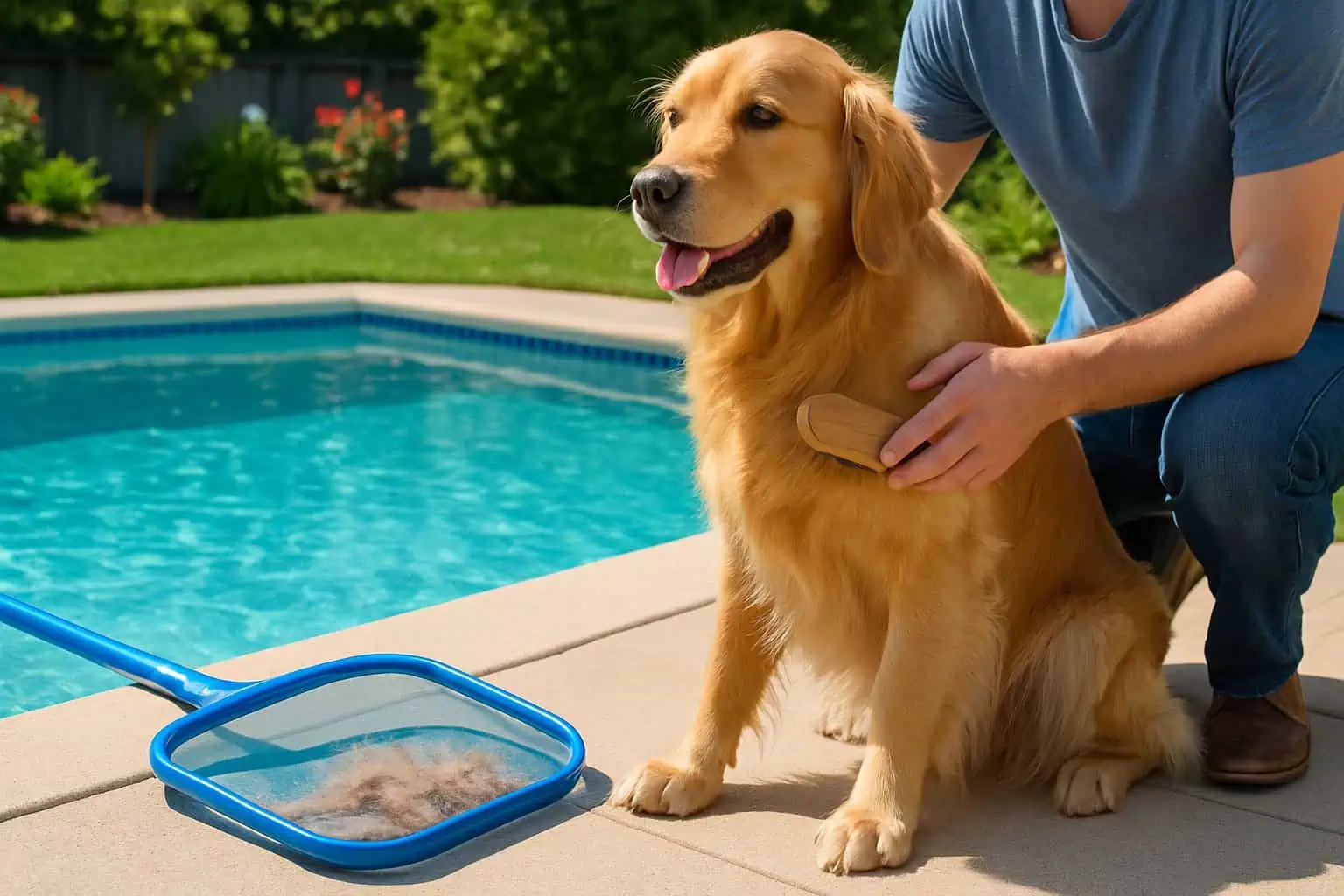
Pet hair piles up in pools faster than you’d expect when dogs swim in the pool. But a few simple habits can keep most of it out of the water and away from your pool filter.
Brushing and Grooming Pets Before Swimming
Give your pets a good brush before they swim. This knocks out the loose fur that would otherwise end up floating around.
Here’s a basic routine:
- Use a deshedding brush or something made for your pet’s coat.
- Brush outside so you don’t just move the problem indoors.
- Bathe pets regularly to get rid of extra dirt and hair.
Table: Recommended Grooming Frequency
| Pet Type | Grooming Frequency |
|---|---|
| Short-haired dog | 1-2 times a week |
| Long-haired dog | 3-4 times a week |
| Cats | 2-3 times a week |
A little brushing goes a long way for your pool and your pet’s coat.
Using Pool Safety Covers and Fencing
Safety covers keep pets (and their hair) out of the pool when you’re not looking. They also block leaves and other junk.
Look for a cover that:
- Fits snugly over the pool.
- Can hold your pet’s weight if they wander onto it.
- Comes off and goes on without a fight.
Fencing is another solid move. A four-foot-high fence with no big gaps keeps most pets out. Gates should close and lock on their own.
Besides keeping things cleaner, these also make your pool safer for everyone.
Limiting Dog Swim Time
Let’s be real: the longer your dog swims, the more hair you’ll find in the pool. Big, double-coated breeds shed even more.
Try this:
- Limit swims to one or two short sessions a day.
- Dry and brush your dog after swimming to grab loose hair.
- Encourage them to hang out on the deck or grass between dips.
Setting some boundaries keeps the pool cleaner and your filter happier.
Routine Pool Cleaning Strategies
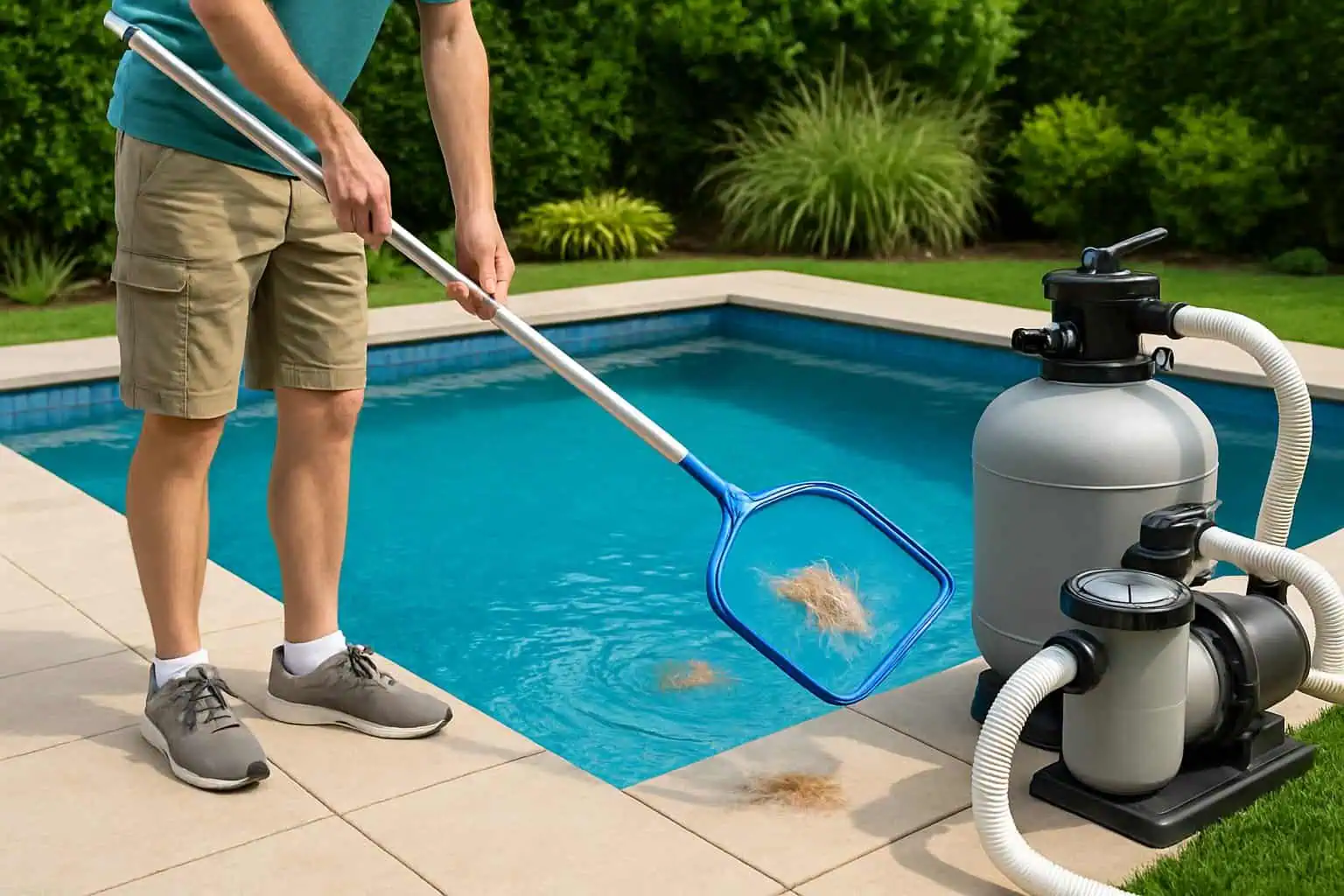
Staying ahead of pet hair in your pool is all about regular cleaning and using the right tools. If you act quickly, you can stop most hair from ever reaching the filter.
Vacuuming and Surface Skimming
Vacuuming gets hair off the pool floor. A pool vacuum, either manual or robot, picks up the fine stuff that skimmers miss. If you’ve got swimming pets, clean more often during the season.
Don’t skip surface skimming. Use a telescopic net or fine-mesh basket to scoop up floating hair before it sinks. Skimmer socks or nylon covers inside the skimmer basket work wonders and are easy to swap out.
Vacuum and skim after every pet swim. Clean out the skimmer baskets and backwash filters regularly. That’s how you keep the system running smooth and avoid filter clogs.
Manual Removal of Pet Hair
Manually removing pet hair sounds basic, but it works. Before your pet swims, brush or bathe them to get rid of loose hair. That means less ends up in the pool to begin with.
After swimming, use a pool brush on the walls and steps to knock off any stuck hair. Scoop up visible hair with a leaf rake or hand skimmer. Some people toss in floating mats or tennis balls—hair clings to them, making it easier to collect.
Stick to a routine, and pair it with pre-swim grooming. Your pool (and filter) will thank you.
Choosing the Right Pool Filter Type for Pet Owners
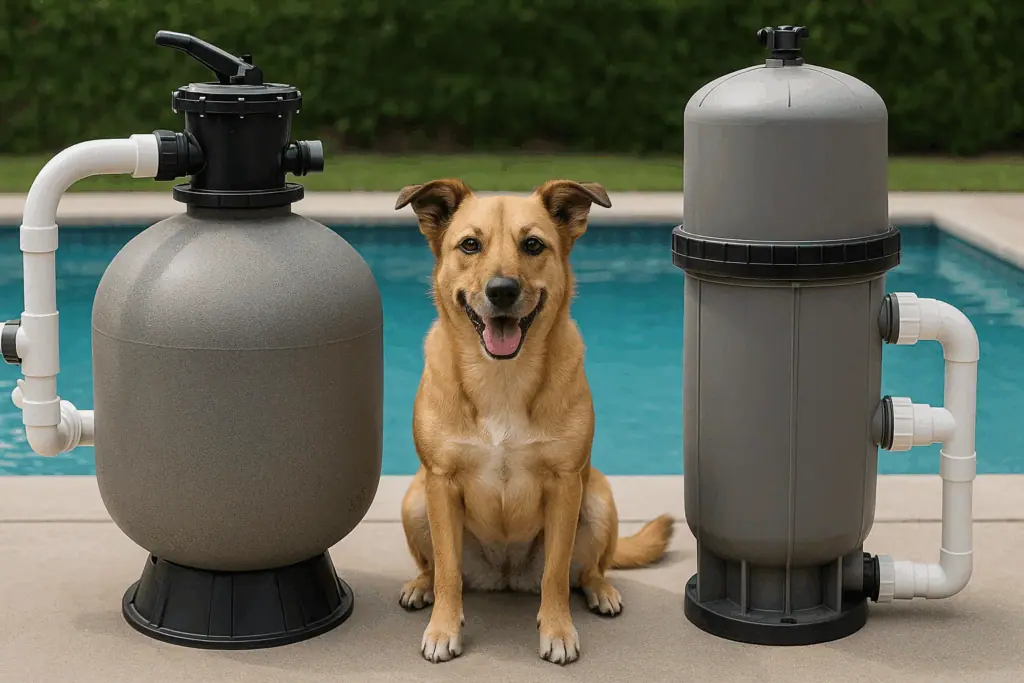
Pet hair can mess with pool filters and knock down their performance. Picking the right filter, using sediment chambers, and keeping up with filter maintenance makes a big difference if you’ve got pets.
Sand Filter vs. Cartridge Filter for Pet Hair
Sand filters use—you guessed it—sand to trap debris. They’re good for big stuff, but fine pet hair sometimes slips through. Cleaning is easy, though: just backwash and you’re done.
Cartridge filters use a fabric cartridge to catch smaller particles, including pet hair. They grab more hair, but they can clog up pretty fast if your dog swims a lot. Cleaning them can be a pain—hair wraps around the cartridge and doesn’t rinse off easily. Some owners use filter socks or hair nets in the skimmer to catch hair before it hits the main filter.
Table: Filter Features for Pet Hair
| Filter Type | Captures Pet Hair | Ease of Cleaning | Cost to Maintain |
|---|---|---|---|
| Sand Filter | Moderate | Easy (backwash) | Lower |
| Cartridge Filter | High | Moderate/Hard | Higher |
Sediment Chamber Benefits
A sediment chamber sits in your filtration system and lets debris like pet hair settle out before hitting the main filter. It helps keep filters from clogging and makes them last longer.
Add a sediment chamber or fine-mesh skimmer basket to trap hair early. They’re simple to empty and maintain. If your pets are in the pool a lot, this little upgrade can save you a lot of filter cleanings.
Sediment Chamber Advantages:
- Reduces filter clogs
- Helps trap fine pet hair
- Can lower overall filter wear
Cleaning and Replacing Filter Media
If your pets love to swim, you’ll need to clean your pool more often. Sand filters usually need a good backwash every few weeks, but if you’re dealing with a lot of pet hair, you might find yourself doing it more often just to keep the water flowing right.
For cartridge filters, pop them out and hose them down whenever you notice the water pressure creeping up or the flow slowing down. Pet hair can really wrap itself around the filter, so sometimes a soft brush helps break it loose before you spray. If the cartridge looks rough or just doesn’t bounce back after cleaning, it’s probably time for a new one.
Don’t forget to check the sediment chamber or skimmer baskets—daily, if your pets are in and out of the pool a lot. Pull out hair and debris so your filter doesn’t get overwhelmed.
Managing Other Contaminants Associated with Pets
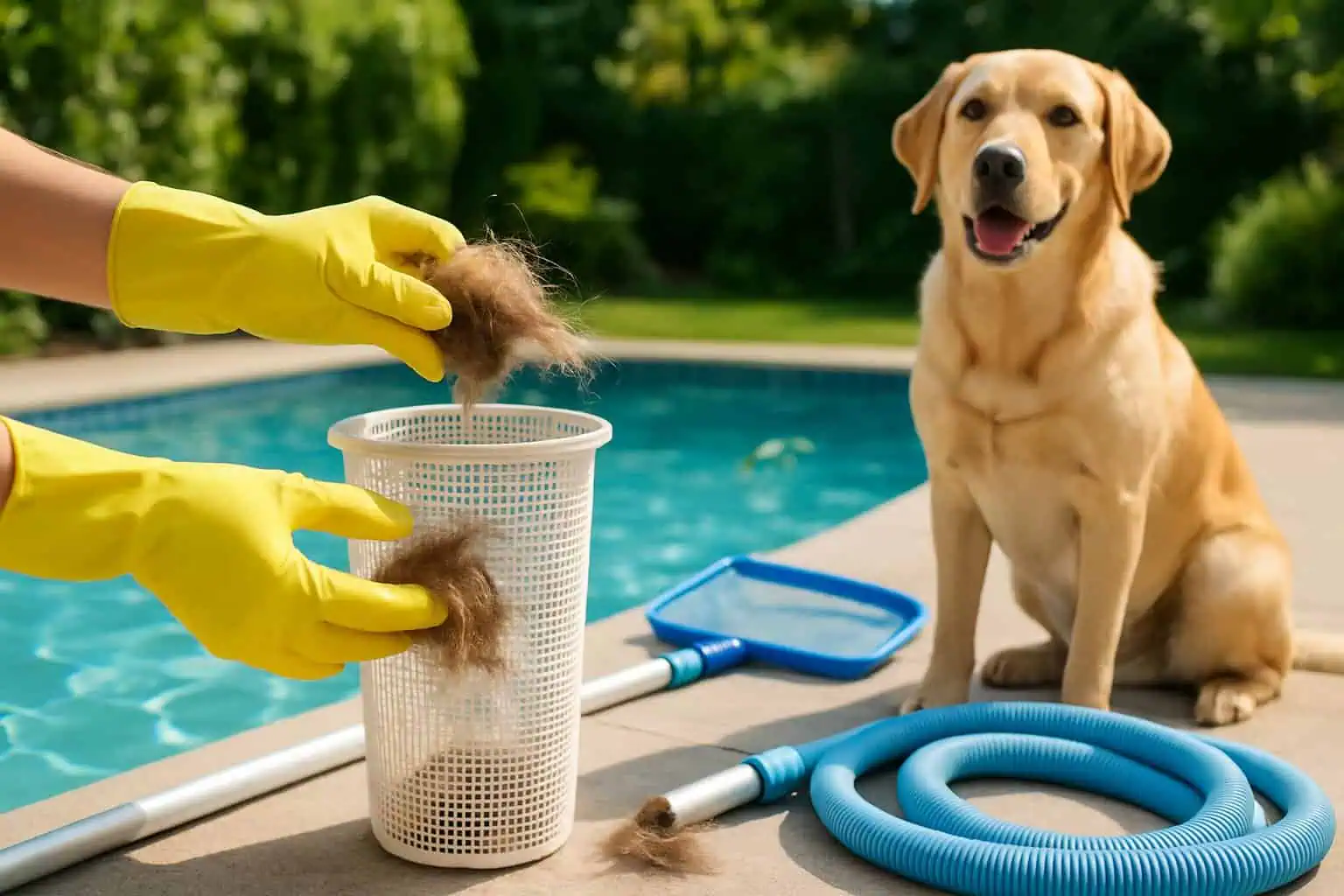
Let’s be honest, pets bring in more than just fur. There’s algae spores, pollen, grass, body oils—and sometimes sunscreen or hair products if they’ve been pampered.
Controlling Algae Growth and Pollen
Algae tends to show up when there’s extra organic matter, like hair or dirt from paws. If you keep up with regular cleaning and don’t let your chlorine drop, you’ll have way fewer algae issues. Some people swear by using an algaecide once a week, especially after pets swim—can’t hurt, right?
Pollen is another sneaky one. It sticks to your pet’s coat and ends up in the pool. To cut down on pollen:
- Give pets a quick rinse or brush before they jump in.
- Toss a pool cover on when you’re not swimming.
- Skim the water daily if pollen’s high.
Both algae and pollen have a knack for clogging filters, so those cleaning routines really matter.
Minimizing Oils, Grass, and Human Hair
Pets can bring in body oils and even traces of sunscreen if they’ve just had a spa day or someone put sunblock on them. These oils leave a film on the pool walls and gum up the filter. It helps to remind everyone—humans included—to shower before swimming, and to skip oily hair products on pool days.
Grass? It gets everywhere, especially after a romp in the yard. A mat by the pool or a quick towel-off can make a surprising difference.
Let’s not forget human hair—if there’s a crowd in the pool with pets, filters fill up fast. Hair catchers over pool drains or in skimmer baskets can snag a lot before it reaches the main filter. Just make sure to clean those baskets and filters often.
Balancing Pool Chemicals for Optimal Filter Performance
Getting your pool chemicals right makes everything easier. Clean water, happy filters, and less hassle with pet hair. You’ll want to keep an eye on sanitizer levels, understand chlorine use, and handle acids with care.
Maintaining Chlorine Levels and Sanitizers
Chlorine is your main line of defense—it kills bacteria, keeps algae in check, and helps break down oils, hair, and skin cells.
Aim for chlorine levels between 1-3 ppm (parts per million). Test the water with strips or kits—whatever’s easiest. Add chlorine tablets or liquid chlorine as needed. Automatic feeders can help keep things steady if you don’t want to fuss with it every day.
You can use bromine or other sanitizers, but most folks stick with chlorine. If sanitizer levels get too low, bacteria start building up on pet hair and your filter gets clogged.
Managing Chlorine Demand
Chlorine demand just means how much chlorine your pool needs to stay clean. When dogs swim, they shed hair, skin cells, and oils—all of which use up chlorine faster.
If chlorine drops too low, the filter ends up working overtime because the sanitizer isn’t breaking down any contaminants. After big swim sessions with pets, always check your chlorine.
Here’s what helps:
- Test chlorine levels after pets swim.
- Shock the pool if the chlorine’s low or the water looks off.
- Keep skimmers and filters clear of hair to give your sanitizer a fighting chance.
Using Muriatic Acid Responsibly
Muriatic acid is what you’ll use to lower pool water pH and keep alkalinity in check. If your pH is balanced, chlorine works better and your filter won’t get crusted up with detritus.
Shoot for a pH between 7.2 and 7.6. If it climbs too high, chlorine loses its punch and you’ll see more hair and gunk building up. Add muriatic acid in small doses—gloves and eye protection are a must. Always pour acid into water, never the other way around. Seriously, don’t mess that up.
Some tips:
- Check your pool’s pH before adding acid.
- Stick to the dosing instructions for your pool size.
- Store acid somewhere safe, away from pets and kids.
When your pH and alkalinity are dialed in, sanitizers can actually do their job, and you’ll spend less time unclogging filters.
Special Pool Considerations for Pet Hair Management
The way your pool is built makes a big difference in how pet hair moves around and gets filtered out. Dealing with dog hair in an inground pool isn’t quite the same as in an above ground pool, so you’ll want to tweak your approach.
Adapting for Inground Pools vs. Above Ground Pools
Inground pools usually have beefier pumps and built-in skimmers, so they can grab more pet hair before it ever hits the filter. You can line skimmer baskets with fine mesh—something like a nylon stocking works great—to trap extra hair. Leaf rakes and pool vacuums help with the rest.
Above ground pools? Their smaller pumps clog up faster when there’s a lot of pet hair. Check the skimmer basket every day, maybe even twice if you’ve got a hairy dog. Pre-filters for the pump intake and fine mesh filter socks can save your equipment from taking a beating.
Here’s a quick comparison:
| Feature | Inground Pools | Above Ground Pools |
|---|---|---|
| Typical Pump Size | Large | Small |
| Skimmer Type | Built-in/Multiple | Simple/One |
| Filter Clogging | Less often | More frequent |
| Best Tools | Mesh liners, vacuums | Pre-filters, socks |
Honestly, brushing and de-shedding your pets before they swim is probably the best move, no matter what kind of pool you have. It just saves a lot of headaches down the line.
Pet Hair Solutions for Hot Tubs
Hot tubs are pretty small, so pet hair piles up fast and can block jets or filters in no time. The hot water? It just seems to loosen even more fur. Honestly, it’s smart to rinse pets really well before letting them hop in.
Most hot tubs use cartridge filters, and those things clog quickly with hair. I like using a floating skimmer made for tight spaces. You can also toss a mesh cover or a fine net over the suction intake—this catches bigger clumps before they get sucked into the filter.
Cleaning the filter often makes a difference, since hot tub filters get tough to rinse when they’re packed with hair. Sometimes I run the jets on low with the cover off for a few minutes after using the spa. That way, the hair drifts toward the skimmer, and cleaning up feels a bit less like a chore.


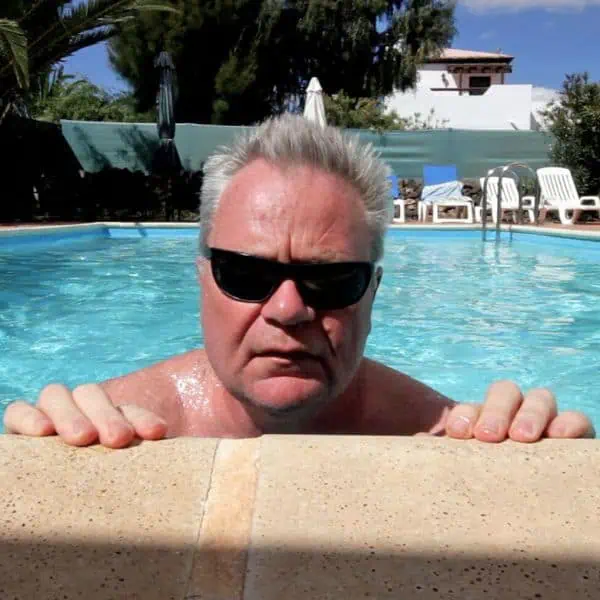


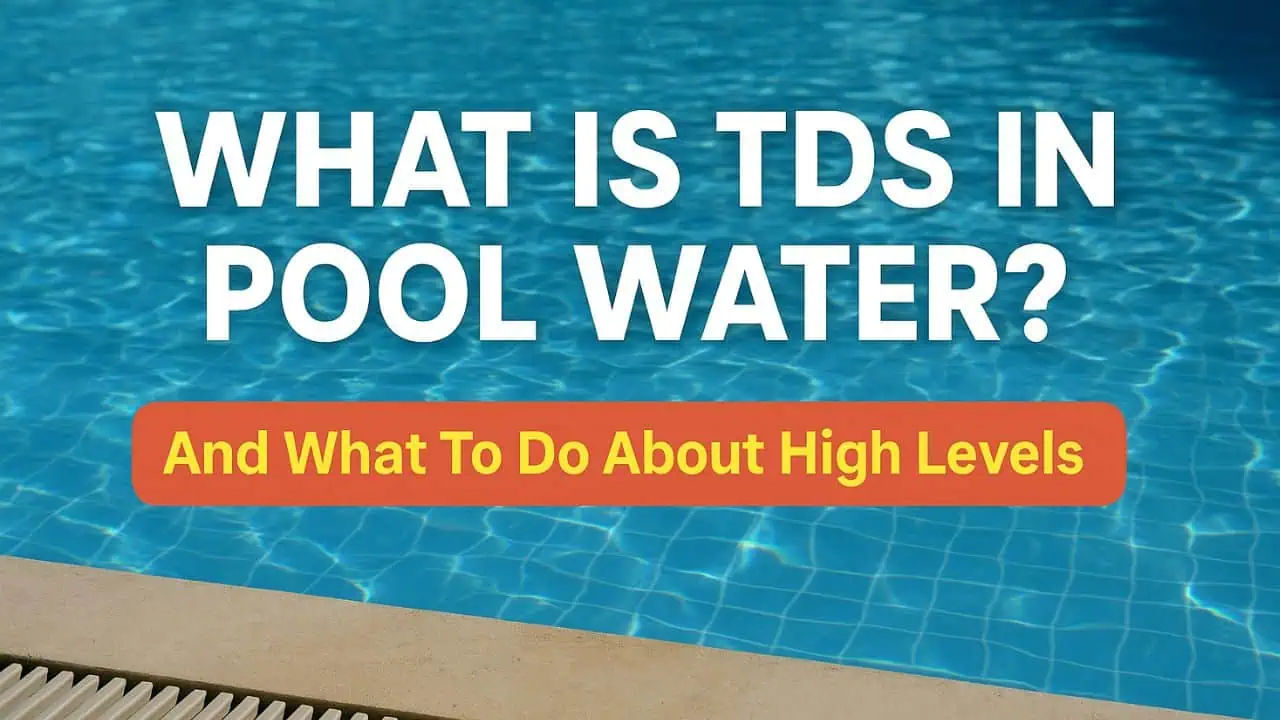
Leave a Reply